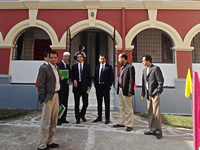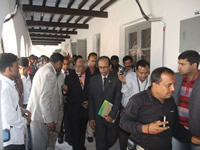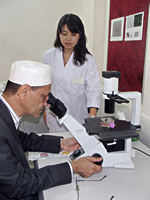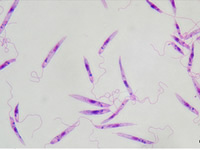
Over 100 officials, researchers, and local medics attended the SKKRC inauguration ceremony.

SKKRC occupies the old isolation wing of Surya Kanta Hospital in Mymensingh, Bangladesh.

Guests examined protozoa culture flasks under the guidance of Assist. Prof. Chizu Sanjoba (right).

Cultured protozoa at the flagellate stage, stained for viewing by microscope
The Surya Kanta Kala-azar Research Centre (SKKRC) in Mymensingh in Bangladesh was formally opened on December 2, 2012. Established through multi-sector collaboration between the government of Bangladesh, DNDi (Drugs for Neglected Diseases initiative), icddr,b (International Centre for Diarrhoeal Disease Research, Bangladesh), and a SATREPS project, the Centre is a research facility focused on eliminating visceral leishmaniasis (kala-azar). The inauguration was widely covered in the local media.
The centre is located in a district where there are severe issues with poverty and a high incidence of kala-azar, and where it is unusual to have a research facility specializing in the diagnosis and treatment of kala-azar. The location gives the potential to have an impact on the disease that could not be achieved elsewhere.
This initiative is part of the SATREPS project "Research and Development of Prevention and Diagnosis for Neglected Tropical Diseases, Especially Kala-Azar," headed by Associate Prof. Eisei Noiri of University of Tokyo Hospital. It is part of the SATREPS program funded jointly by JICA and JST.
Kala-azar is an infectious disease caused by protozoan parasites of the Leishmania genus. Symptoms appear 1-2 months after being bitten by a sand fly carrying the parasite. The disease causes swelling of the liver and spleen, and without intervention is fatal in 90% of cases. According to the World Health Organization (WHO), over 300,000 new cases of kala-azar occurred annually, with 90% occurring in four countries: Sudan, Bangladesh, India, and Nepal.
In 2005, the health ministers of Bangladesh, Nepal, and India made a commitment with the WHO to target the elimination of kala-azar, reducing the incidence of new cases in the Indian subcontinent to 1 in 10,000 population by 2015. Medication and other strategies have been steadily reducing the number of fatalities, but parasites with resistance to the drugs have emerged, and there are still between 4000 and 9000 cases detected locally each year.
The project aims to transfer technology for advanced clinical and research methods from Japan to Bangladesh and to contribute to the training of people who can work on diagnosis, treatment, and prevention, thereby significantly assisting the movement to eliminate kala-azar. SKKRC will play a central role in this initiative. Its location in the Mymensingh district was chosen because it was the district of Bangladesh with the greatest number of people afflicted by the disease. Taking over an old isolation wing (a two-story brick structure with a floor area of about 1,400 square meters) at the 120 year-old Surya Kanta Hospital, the Research Centre includes a 20-bed clinical unit and research facility, equipped with state-of-the-art equipment provided by Japan. Staffed by 2 doctors and 3 nurses, the Centre commenced diagnostic and treatment services in December 2011. Attracted by the Centre's reputation, the number of patients grew, particularly cases resistant to conventional therapy, and a total of 260 patients were diagnosed and treated in the first year.
Over a hundred officials, researchers, and local medics attended the Centre's inauguration ceremony on December 2, 2012. SATREPS director Hideki Mizuma, visiting from Japan, addressed the guests, saying "Kala-azar is one of the diseases that had been neglected by international society as regional issues, but are now having a worldwide impact, increasing the significance of international collaboration. I am firmly convinced that the Centre will provide hope for people suffering from kala-azar." The International Centre for Diarrhoeal Disease Research, Bangladesh (icddr,b), which is the local research institute participating in the SATREPS project, reported the inauguration on its website, quoting the Honorable State Minister of Health and Family Welfare, Captain (Rtd) Dr. Mozibur Rahman Fakir, MP's comment “This is a great initiative, and a landmark of strong collaboration between the Government of Bangladesh, icddr,b and Japan.”
During a tour of the laboratory before the inauguration ceremony, visitors showed great interest in the microscopes, where they were able to observe live parasites, protozoa of the Leishmania genus. Prof. Noiri explained the significance of the Centre, saying "The importance of the Research Centre comes from the fact that a diagnostic facility has been established in a district where there are a lot of kala-azar cases. We are keen to make full use of its capabilities to detect infection at an early stage with simple but appropriate diagnostic tools, to properly monitor drug resistance, to support vector control technology, and to train medics and other workers."
Links
University of Tokyo press releases:
http://www.u-tokyo.ac.jp/en/news/topics/2012.html
International Centre for Diarrhoeal Disease Research, Bangladesh (icddr,b) news: icddr,b supports new initiative to eliminate kala-azar in Bangladesh:
http://www.icddrb.org/media-centre/news/4082-icddrb-supports-new-initiative-to-eliminate-kala-azar-in-bangladesh
Local news article (The Daily Star): Kala-azar research centre opens in Mymensingh:
http://www.thedailystar.net/newDesign/news-details.php?nid=259659
SATREPS:
http://www.jst.go.jp/global/english/
SATREPS (Science and Technology Research Partnership for Sustainable Development) is a Japanese Government program that promotes international joint research targeting global issues. Funded jointly by Japan Science and Technology Agency (JST) and the Japan International Cooperation Agency (JICA), SATREPS works through three- to five-year projects involving partnerships between researchers in Japan and researchers in developing countries. There are currently 66 SATREPS projects in 34 countries
SATREPS project: Research and Development of Prevention and Diagnosis for Neglected Tropical Diseases, Especially Kala-Azar
(Principal Investigator: Associate Prof. Eisei Noiri, The University of Tokyo Hospital)
http://www.jst.go.jp/global/english/kadai/h2217_bangladesh.html
Kala-azar* is a serious disease that infects another 300,000 of the world's poorest people every year. It has long been neglected in Bangladesh and other countries where it mainly afflicts the poorest of the poor, and is not only a health hazard, but also a major obstacle to socioeconomic development. This project aims to establish genetic diagnostic, immuno-diagnostic, urine test and other diagnostic techniques tailored to local conditions, and get to grips with the malady.
* Kala-azar, also known as black fever or visceral leishmaniasis, is a zoonotic disease affecting internal organs that is caused by protozoan parasites of the Leishmania genus. Symptoms include fever, severe anemia, abdominal swelling, desiccation, and blackening of the skin.JST, an integrated organization of science and technology in Japan, establishes an infrastructure for the entire process from the creation of knowledge to the return to the society. For more information, visit http://www.jst.go.jp/EN/